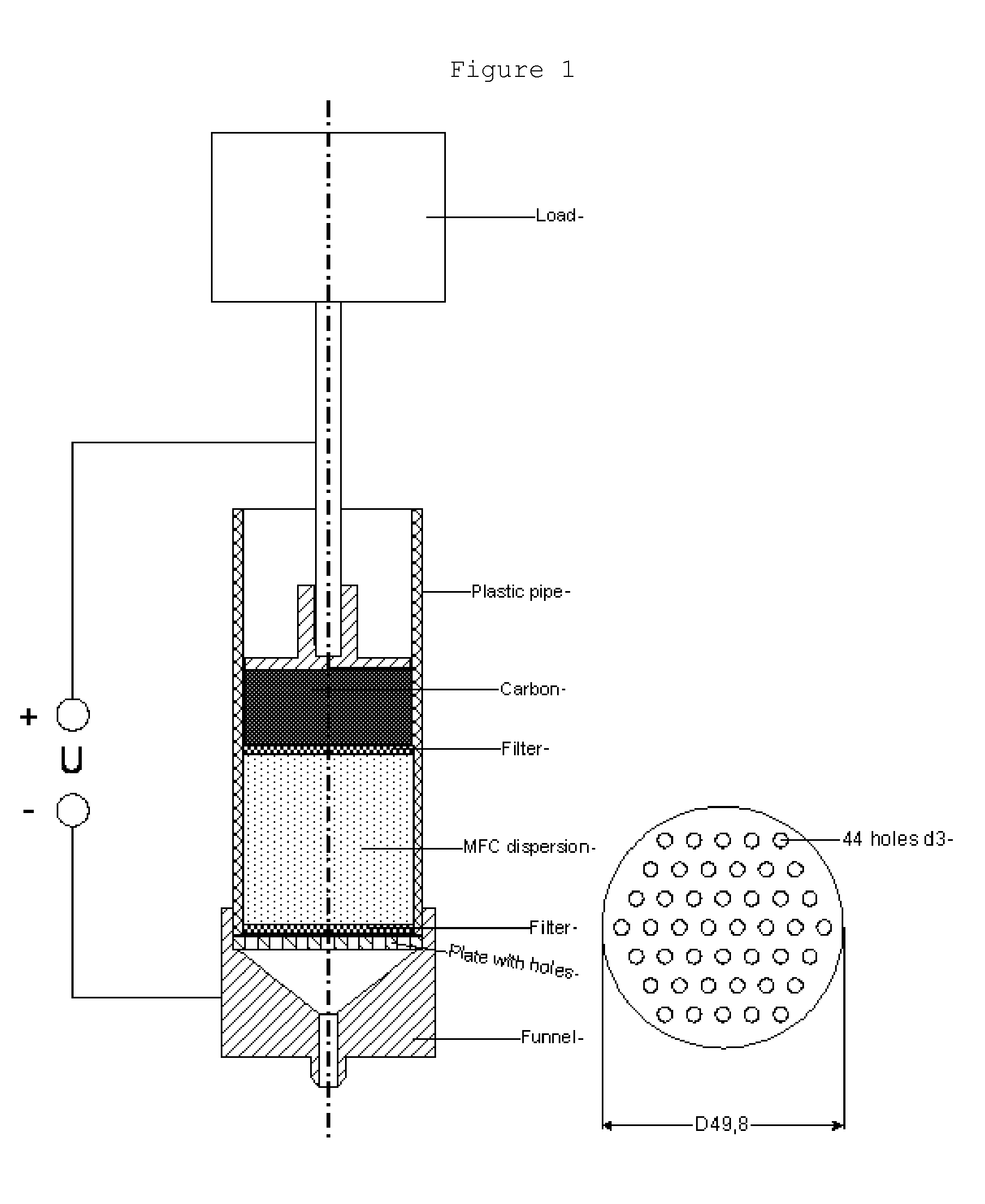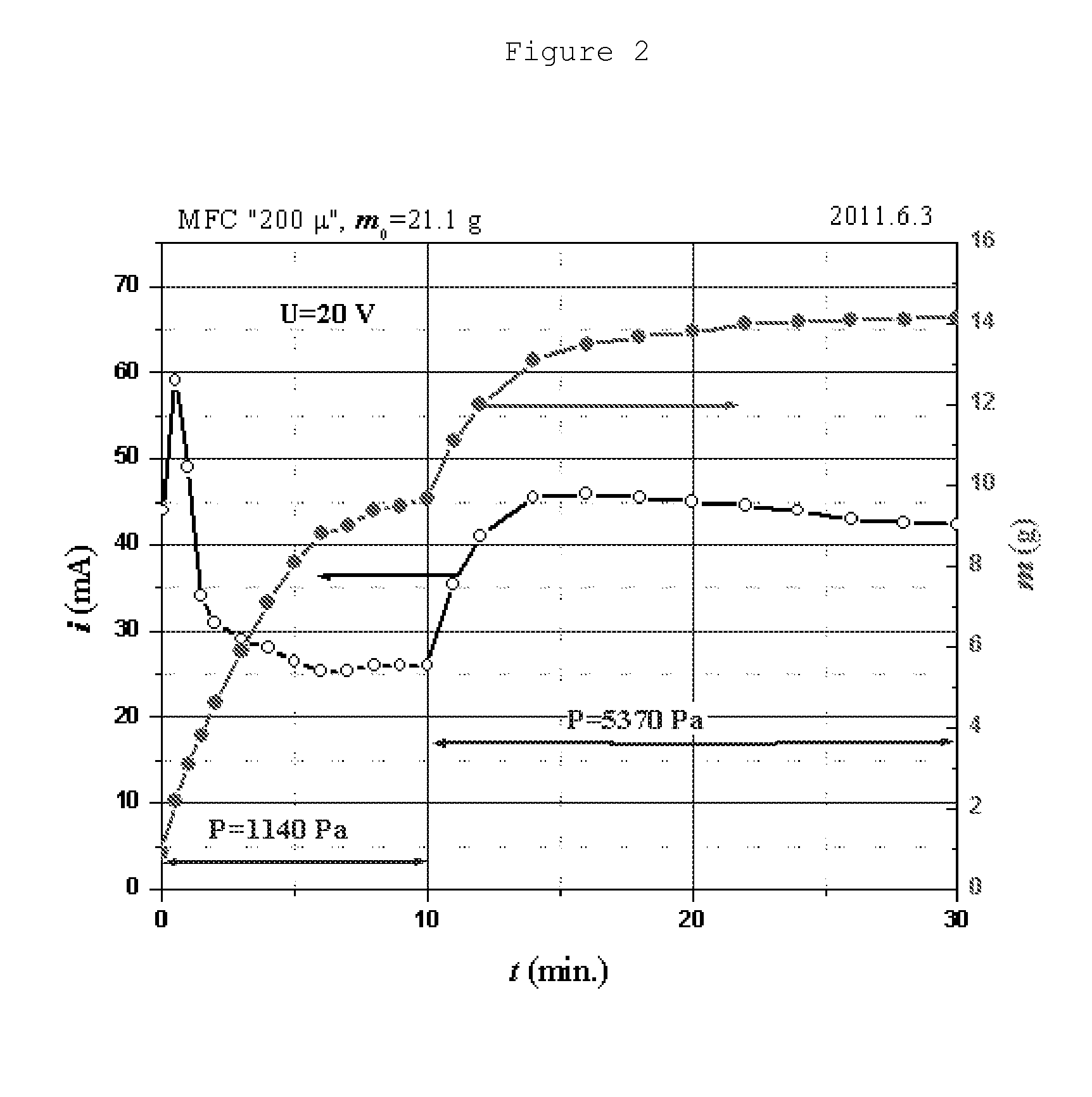Process for treating cellulose and cellulose treated according to the process
a technology of cellulose and cellulose, applied in the field of purification, can solve the problems of difficult purification, difficult to reduce the water content of a slurry comprising microfibrillation, etc., and achieve the effect of not being so cost-efficient to use in large-scale processes and energy-intensive techniques
- Summary
- Abstract
- Description
- Claims
- Application Information
AI Technical Summary
Benefits of technology
Problems solved by technology
Method used
Image
Examples
examples
1. Experimental Set-Up
[0079]For investigation of MFC dispersion dewatering an experimental setup was assembled, scheme of which is on FIG. 1. It consists of a plastic pipe with internal diameter 46 mm, fitted into a stainless steel funnel. At the lower end of the pipe there is a plate with holes, also made of stainless steel, which serves as the lower electrode, usually cathode. A paper filter is placed on the plate, the MFC dispersion is loaded onto the filter. On top or the MFC column there is one more paper filter, after this the upper electrode (anode) is placed.
[0080]The best results were achieved with platinum electrode—no process changes due to the electrode corrosion or contamination were observed.
[0081]The setup of FIG. 1 constituted a cell with MFC investigated; DC voltage was applied into it from the current source. The water, emerging from the funnel was assembled into beaker, which was situated on top of a balance; the mass of the water extracted from MFC was registered...
example 2
[0088]Reference MFC (initial MFC)—dry content (IR) 1.7%
Salt / Metal contents based on dry matter;
Al 9.5 mg / g
Fe 16 mg / g
Ca 1200 mg / kg
Cu 5.5 mg / kg
K 310 mg / kg
Mg 210 mg / kg
Mn 1.1 mg / kg
Na 1400 mg / kg
Ni 1.6 mg / kg
Pb 1.1 mg / kg
Si 76 mg / kg
Zn 5.9 mg / kg
[0089]Dewatering Procedure 1—Only Removing Water;
[0090]A paper filter was places on cathode then MFC and then a second paper filter. After this the anode was laid on the top of this. The pressure (of weight of anode) was 750 kPa. After short time (2 min) an additional weight was added (pressure to 2400 Pa). The voltage during dewatering was 100V and time 640 s.
Procedure was repeated 3 times and pressure was increased (last time 4.6*10̂5 Pa).
Dewatered MFC (electro-osmosis MFC)—results are given below:
Salt / Metal contents based on dry matter 30.5%
Al 8.5 mg / kg
Fe 11 mg / kg
Ca 30 mg / kg
Cu 0.69 mg / kg
K 85 mg / kg
Mg 5.7 mg / kg
Mn 0.24 mg / kg
Na 12 mg / kg
Ni 0.68 mg / kg
Pb <0.4 mg / kg
Si 13 mg / kg
Zn 1.5 mg / kg
example 3
[0091]Reference MFC (initial MFC)—dry content (IR) 1.7%
Salt / Metal contents based on dry matter;
Al 9.5 mg / g
Fe 16 mg / g
Ca 1200 mg / kg
Cu 5.5 mg / kg
K 310 mg / kg
Mg 210 mg / kg
Mn 1.1 mg / kg
Na 1400 mg / kg
Ni 1.6 mg / kg
Pb 1.1 mg / kg
Si 76 mg / kg
Zn 5.9 mg / kg
[0092]Dewatering Procedure 2—Removing Water and Washing with Acetone
[0093]MFC was dewatered 5 min (as in procedure 1 above i.e. Example 2). After this the current was switched off and acetone was added (about the same amount as water was removed in previous step). After this dewatering was started and continued about 10 min.
Dewatered MFC (electro-osmosis MFC with acetone)—results given below:
Salt / Metal contents based on dry matter 23.5%
Al 4.6 mg / kg
Fe 10 mg / kg
Ca 10 mg / kg
Cu 0.68 mg / kg
K 40 mg / kg
Mg 7.1 mg / kg
Mn 0.13 mg / kg
Na 14 mg / kg
Ni 0.50 mg / kg
Pb <0.4 mg / kg
Si 13 mg / kg
Zn 1.5 mg / kg
PUM
| Property | Measurement | Unit |
|---|---|---|
| voltage | aaaaa | aaaaa |
| temperature | aaaaa | aaaaa |
| temperature | aaaaa | aaaaa |
Abstract
Description
Claims
Application Information
 Login to View More
Login to View More - R&D
- Intellectual Property
- Life Sciences
- Materials
- Tech Scout
- Unparalleled Data Quality
- Higher Quality Content
- 60% Fewer Hallucinations
Browse by: Latest US Patents, China's latest patents, Technical Efficacy Thesaurus, Application Domain, Technology Topic, Popular Technical Reports.
© 2025 PatSnap. All rights reserved.Legal|Privacy policy|Modern Slavery Act Transparency Statement|Sitemap|About US| Contact US: help@patsnap.com



